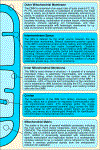Mechanistic connections between mitochondrial biology and regulated cell death
- PMID: 33887204
- PMCID: PMC8102388
- DOI: 10.1016/j.devcel.2021.03.033
Mechanistic connections between mitochondrial biology and regulated cell death
Abstract
The ancient, dynamic, and multifaceted functions of the mitochondrial network are essential for organismal homeostasis and contribute to numerous human diseases. As central hubs for metabolism, ion transport, and multiple macromolecular synthesis pathways, mitochondria establish and control extensive signaling networks to ensure cellular survival. In this review, we explore how these same mitochondrial functions also participate in the control of regulated cell death (RCD). We discuss the complementary essential mitochondrial functions as compartments that participate in the production and presentation of key molecules and platforms that actively enable, initiate, and execute RCD.
Keywords: cell biology; mitochondrial function; programed cell death; regulated cell death; signal transduction; stress signaling.
Copyright © 2021 Elsevier Inc. All rights reserved.
Figures



References
-
- Baines CP, Kaiser RA, Purcell NH, Blair NS, Osinska H, Hambleton MA, Brunskill EW, Sayen MR, Gottlieb RA, Dorn GW, et al. (2005). Loss of cyclophilin D reveals a critical role for mitochondrial permeability transition in cell death. Nature 434, 658–662. - PubMed
Publication types
MeSH terms
Grants and funding
LinkOut - more resources
Full Text Sources
Other Literature Sources
Research Materials

